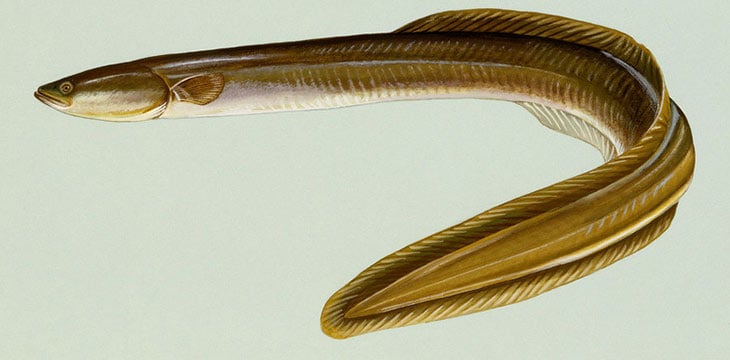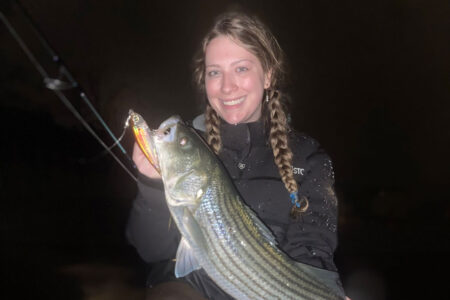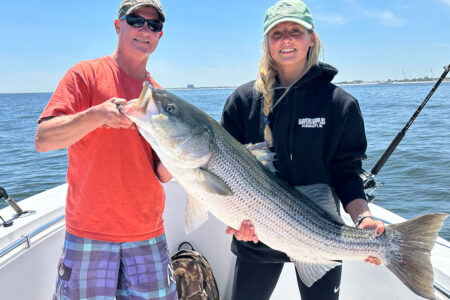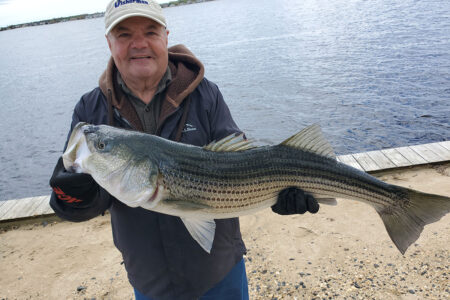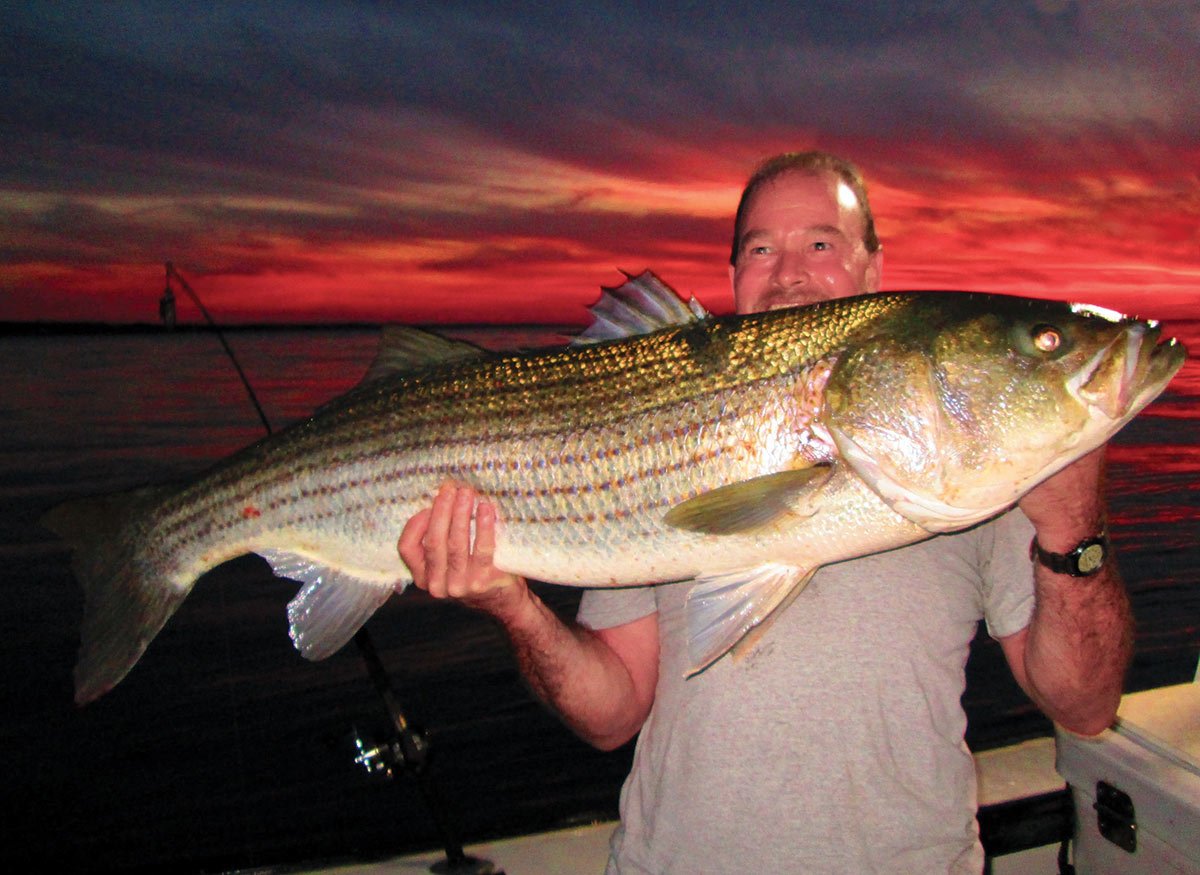
Few techniques are more effective on big stripers than drifting a live eel over fish-holding structure in the dark of night.
Striped bass fishing is my obsession. Looking back through my years on the water, I smile and marvel at the crazy, fun trip it has been. Early on, I worked hard, found great mentors, and eventually got pretty good at striper fishing. If I had to point to one facet of my journey that made me a good striper angler, it has to be embracing night tides. This allowed me to enter an elite group of anglers, the 10percent who catch 90percent of the fish. I truly believe if one wants to enter this rank of anglers, then the fears and apprehension of night fishing must be conquered. Once the night becomes comfortable, a plethora of fish catching opportunities will be the reward.
Why the night? Stripers have excellent night vision; this is because of the great number of rods and cones in their retinas. Rods allow stripers to see excellent in dim or night conditions, and cones allow them to see colors similar to the ability of humans. That being said, stripers only use their vision when up close and personal to prey. A striper’s acute sense of smell allows them to detect prey long before they see them. The final asset used by stripers when feeding is their lateral line. These nerve endings allow stripers to detect sound and vibration at great distances. All of these abilities combine to give stripers a great advantage over their prey at all times, and even more so at night.
Among the other advantages to fishing nighttime tides is that there are typically less boats on the water at night than during the day. Of course, Friday and Saturday nights can at times be an exception to that rule, especially during full moons when some skippers find comfort in the better visibility provided by that big light in the sky. However, for the most part, boat traffic is not an issue at night. During the day I’ve seen it happen again and again as boat traffic will very often put stripers off their feed or move them out of an area. At night, stripers do not seem to be bothered by boats nearly as much as they are during daylight. This means that once I find feeding stripers at night, I can usually stay on them for a good portion of the tide.
My preferred technique when targeting stripers at night also happens to be my favorite way to fish for them. In my opinion, drifting live eels over known fishy structure for big stripersis the ultimate challenge in the striper game. Yeah, yeah – I can hear some out there commenting, “Dude, you’re fishing with bait, how hard can it be?” Well, if you feel that way, fine, but, I can assure you I’m very good at live-eeling and some nights, I can out fish most anglers four or five to one.
Over time, I’ve learned that some of those who fish with me and listen to instruction, will take to the eeling technique quickly. On the other hand, some anglers never seem to get it, no matter how hard I try to teach them. Often, the only reason they catch anything at all is the result of pure luck. I’ll be the first to admit that on some nights it’s better to be lucky than good, but trust me, a good “set of hands” will out fish a novice eeler by a wide margin the majority of the time. So trust me, it isn’t that easy.
I use a fish-finder or 3-way rig when drifting live eels. My leader for live eel fishing is a 5- to 6-foot length of 60-pound monofilament leader with a 9/0 Mustad Demon Perfect Circle Hook tethered to the terminal end. For my main line, I favor KastKing Super Power Braid in 50-pound test. I fish with tight drags, set close to 20 pounds of resistance. This is because I want to end a fight with a big striper as quickly as I can. The longer the fight the more likely bad things will happen. Either you’ll lose the fish, or when you get the bass in the boat the fish will be too spent to be released successfully.
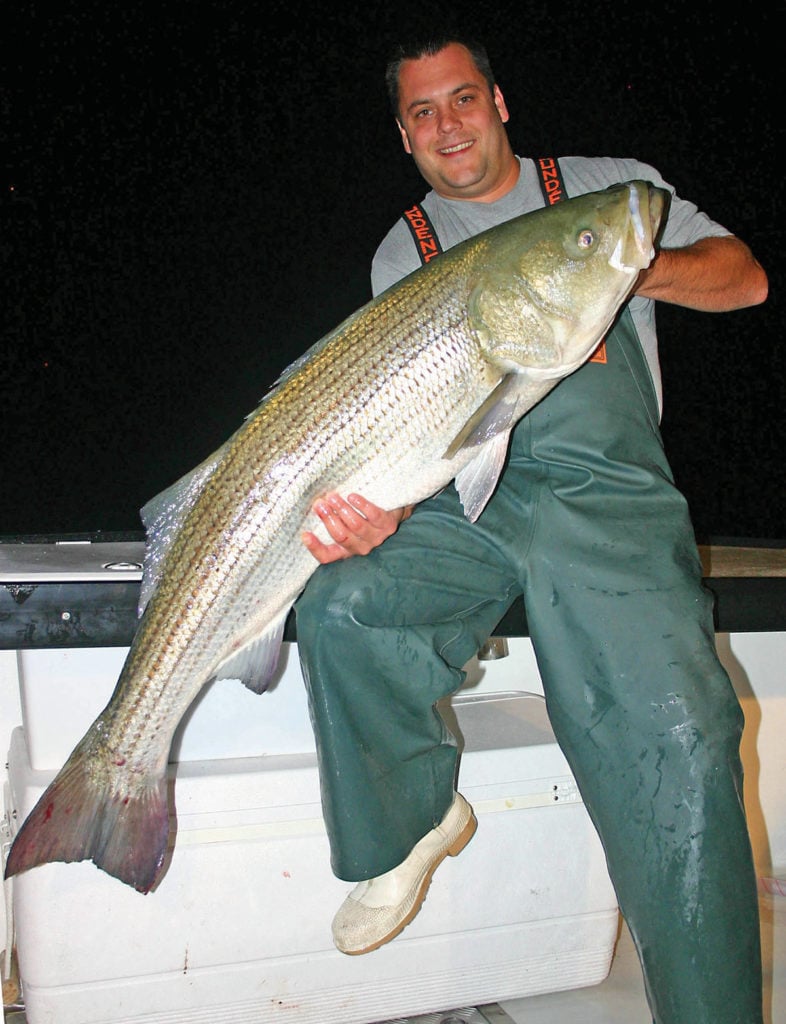
Getting a live eel on the hook can be frustrating. I store my eels on the boat in a bucket with small holes drilled in it. At the beginning of a trip, and a few times during the trip, I pour a scoop of ice on the eels to make them lethargic. Once the eels are iced they are much more cooperative. When it is time to bait up, grab the eel by the head with a clean, dry rag and smack the eel’s tail sharply against the transom a few times. This will slow the eel down long enough to get it in the water without the eel turning your rig into a tangled ball of eel, slime and leader. If you don’t whack the eel, there is a pretty good chance of that happening and is one reason some anglers actually shy away from fishing live eels.
Always use a sinker heavy enough to keep the line angle to the strike zone as straight up and down as possible. This is totally dependent on the waters you fish. Current, water depth and the speed of your drift all factor into how much weight will be required to maintain the proper angle. In Montauk, where I do most of my bass fishing, 6- to 8-ounce sinkers will do the job at the beginning of the tide, but as the current picks up, I increase the sinker weight accordingly. Conversely, as the current slows down, I reduce the weight of my sinker.
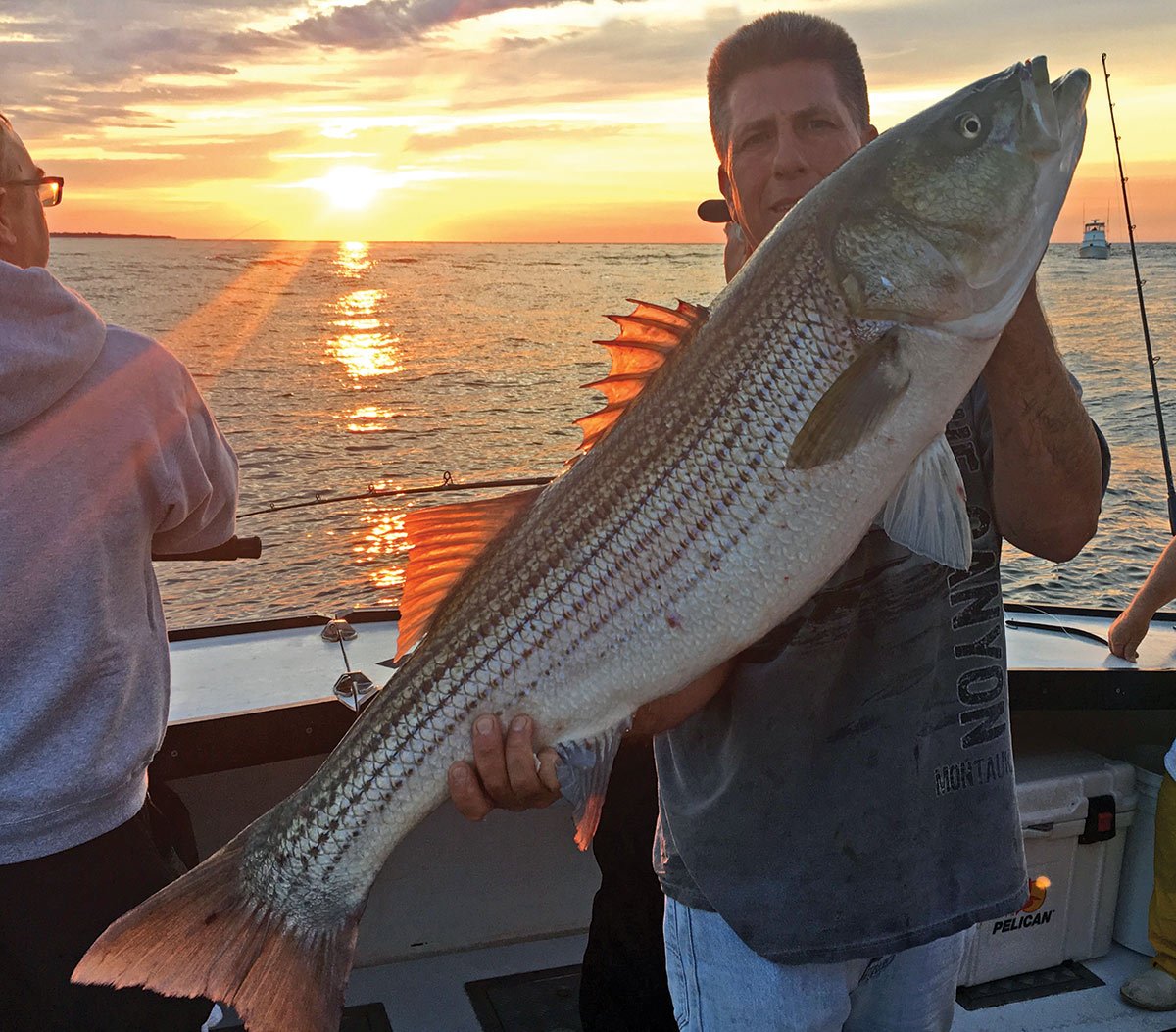
Walking the eel up, over, and back down any bottom structure is a crucial skill to master if you want to master the live-eeling game. I free spool the rig to the bottom, and when the sinker makes contact, I immediately lock up the reel, and take three cranks on the reel handle. I then bring the rod tip up to a 45-degree angle. During the drift when I feel the sinker touch bottom, I take another three cranks on the reel handle, and re-position the rod tip again at the 45-degree angle. I also feel for the bottom every minute or so, by dropping back line and repositioning my rod at the same 45-degree angle. This keeps my eel continuously in the striper’s feeding zone between 5 to 10feet off the bottom.
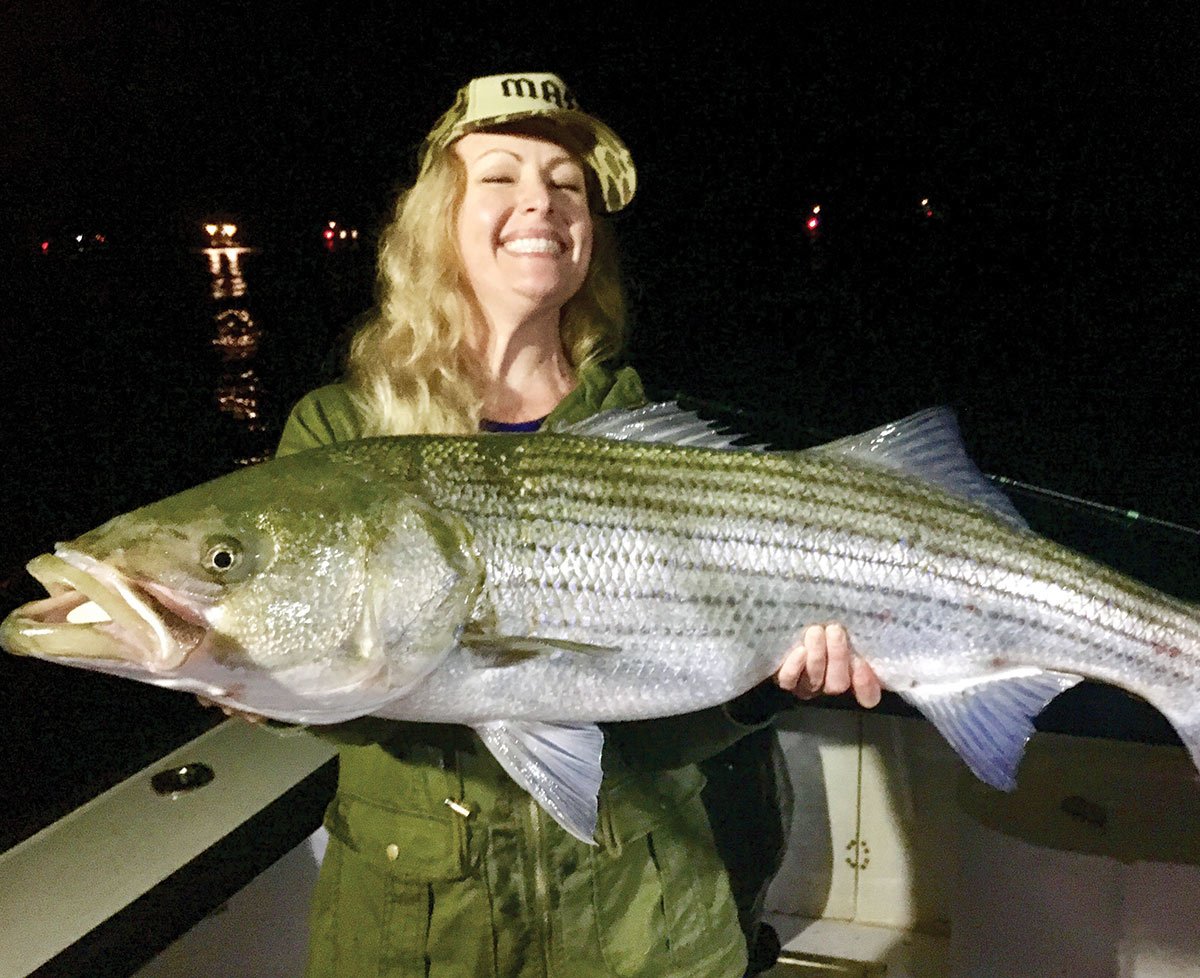
A striper bite on a live eel will feel like two sharp tap, or tugs. The instant you feel this, it is imperative to drop the rod tip towards the water. Dropping the rod creates enough slack in the line to let the striper inhale your eel. There are many nights if one doesn’t drop the tip to the fish, the striper immediately spits the eel out and swims away. This simple act of bowing to the fish often separates the sharpies from the novices in the eeling game. Using a circle hook requires “waiting for the weight.” When it feels like the weight (fish) is about to pull the rod from you, crank the reel handle quickly a few times to set the hook. At this point, some anglers like to sock the hook home with a sharp lift of the rod, but it’s not necessary since cranking the reel handle has already set the hook, typically in the corner of the striper’s jaw.
While this technique is equally effective in places like the Cape May rips, Long Island Sound, the Race and the Sluiceway, there is no place I’d rather be on a summer night than drifting a moon tide in the Montauk rips. I’m simply obsessed by this method of fishing, and I love it to the core. Give this live-eelingtechnique a try, embrace the night, train your hands to do the right thing, and it won’t be long before you’re out-fishing your buddies in the bassing game four or five to one.
|
AMERICAN EEL LIFE HISTORY |
|---|
Credit: USFWS |

